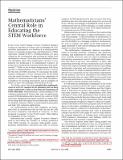Mathematicians’ Central Role in Educating the STEM Workforce
Author(s)
Friedlander, Eric M.; Holm, Tara S.; Ewing, John; Goldin, Rebecca; Jaco, William H.; Stevens, T. Christine; Thompson, Abigail; Vogan, David A; ... Show more Show less
Downloadrtx120901205p.pdf (1.263Mb)
PUBLISHER_POLICY
Publisher Policy
Article is made available in accordance with the publisher's policy and may be subject to US copyright law. Please refer to the publisher's site for terms of use.
Terms of use
Metadata
Show full item recordAbstract
In the recent report Engage to Excel,1 President Obama’s Council of Advisors on Science and Technology (PCAST) identifies mathematics as a bottleneck in undergraduate Science, Technology, Engineering, and Mathematics (STEM) education. Among PCAST’s recommendations are ones
calling for the development and teaching of college-level mathematics courses “by faculty from mathematics-intensive disciplines other than mathematics” and for “a new pathway for producing K–12 mathematics teachers…in programs in mathematics-intensive fields other than mathematics.”2 While we are in sharp disagreement with these specific recommendations, we do share PCAST’s concern for the state of STEM education. We encourage the mathematics
community to focus constructively on the broad view the report sketches. We appeal to the community to amplify its communications with other STEM disciplines, to publicize its teaching innovations, and to redouble its efforts to meet the challenges discussed by PCAST.
Date issued
2012-10Department
Massachusetts Institute of Technology. Department of MathematicsJournal
Notices of the American Mathematical Society
Publisher
American Mathematical Society (AMS)
Citation
Friedlander, Eric M., Tara S. Holm, John Ewing, Rebecca Goldin, William H. Jaco, T. Christine Stevens, Abigail Thompson, and David Vogan. “Opinion.” Notices of the American Mathematical Society 59, no. 09 (October 1, 2012): 1.
Version: Final published version
ISSN
0002-9920
1088-9477